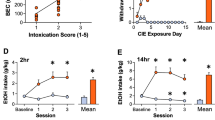Abstract
Rats selectively bred for high alcohol sleep times (HAS) and those that are less affected (LAS) by hypnotic doses (3.0–3.6 g/kg) of ethanol were tested for differential responses to the aversive effects of 1.0 g/kg ethanol in a conditioned place preference task. Likewise, the effects of 0.3–1.0 g/kg ethanol on spontaneous locomotor activity over a 30-min period, as well as the loss of righting reflex with a higher ethanol dose (3.0 g/kg), were determined in these animals. The LAS rats reacted more aversively to 1.0 g/kg during conditioned place aversion testing than the HAS animals and also had a shorter mean sleeping time following 3.0 g/kg ethanol. Furthermore, dose-related depression of spontaneous motor activity was seen in the HAS animals and not in the LAS animals over a 30-min period using doses of 0.3, 0.6, or 1.0 g/kg (10% w/v) ethanol. Taken together, the results indicate that the intoxicating sequelae of high ethanol doses, such as ataxia and sedation, may not be correlated with the aversive effects of low ethanol doses.
Similar content being viewed by others
References
Black RW, Albiniak T, Davis M, Schumpert J (1973) The preference in rats for cues associated with intoxication. Bull Psychonom Soc 2:423–424
Cloninger CR (1987) Neurogenetic adaptive mechanisms in alcohol. Science 236:410–416
Crabbe JC (1989) Genetic animal models in the study of alcoholism. Alcohol Clin Exp Res 13:120–127
Cunningham CL (1981) Spacial aversion conditioning with ethanol. Pharmacol Biochem Behav 14:263–264
Elmer GI, Meisch RA, Goldberg SR, George FR (1990) Ethanol self-administration in long-sleep and short-sleep mice indicates reinforcement is not inversely related to neurosensitivity. J Pharmacol Exper Ther 254:1054–1062
Froehlich JC, Harts J, Lumeng L, Li T-K (1988) Differences in ethanol induced conditioned taste aversion between P and NP rats. Pharmacol Biochem Behav 31:215–222
George FR (1990) Genetic approaches to studying drug abuse: correlates of drug self-administration. Alcohol 7:207–211
George FR, Goldberg SR (1989) Genetic approaches to the analysis of addiction processes. TIPS 10:78–83
Le AD, Kiianmaa M (1990) Characteristics of ethanol tolerance in alcohol drinking (AA) and alcohol avoiding (ANA) rats. Psychopharmacology 94:479–483
Lumeng L, Waller MB, McBride WL, Li T-K (1982) Different sensitivities to ethanol in alcohol-preferring and non-preferring rats. Pharmacol Biochem Behav 16:125–130
Palmer MR, Wang Y, Fossom LH, Spuhler KP (1987) Genetic correlation of ethanol-induced ataxia in cerebellar Purkinje neuron depression among inbred strains and selective lines of rats. Alcohol Clin Exp Res 11:494–501
Spuhler K, Deitrich RA, Baker RC (1990) Selective breeding of rats differing in sensitivity to the hypnotic effects of acute ethanol administration. In: Deitrich RA, Pawlowski AA (eds) National Institutes on Alcohol Abuse and Alcoholism Research Monograph No 20. US Government Printing Office, Washington, DC, pp 87–102
Stewart RB, Grupp LA (1981) An investigation of the interaction between the reinforcing properties of food and ethanol using the place preference paridigm. Prog Neuropsychopharmacology 5:609–613
Tallarida RJ, Murray RV (1987) Manual of pharmacologic calculations with computer programs, 2nd edn. Springer, Berlin Heidelberg New York, pp 110–113, 134–136
van der Kooy D, O'Shaughnessy M, Mucha RF, Kalant H (1983) Motivational properties of ethanol in naive rats as studied by place conditioning. Pharmacol Biochem Behav 19:441–445
Author information
Authors and Affiliations
Rights and permissions
About this article
Cite this article
Schechter, M.D., Krimmer, E.C. Differences in response to the aversive properties and activity effects of low dose ethanol in LAS and HAS selectively bred rats. Psychopharmacology 107, 564–568 (1992). https://doi.org/10.1007/BF02245271
Received:
Revised:
Issue Date:
DOI: https://doi.org/10.1007/BF02245271




